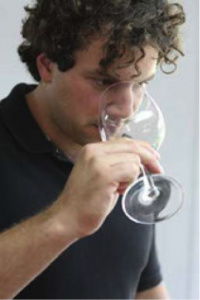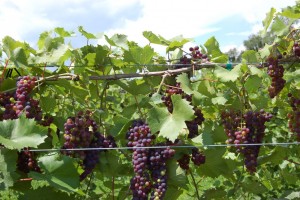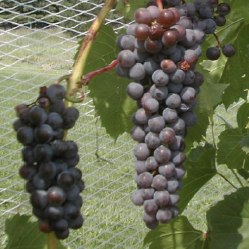Realizing the Aroma Potential Of Cold Hardy Grapes
Giddy up

Piero Spada is a Midwest vineyard and and winery consultant specializing in cold-climate grape and wine production.
It’s an exciting time in the hybrid grape and wine world because for the first time significant research has been carried out on hybrid grapes and wine in search of defining chemical aroma profiles unique to individual varieties! The aromatics of a wine are the subtle nuances (beyond the basic sugars, organic acids, etc.) that are worth pursuing because they can add complexity or another to dimension to your wine.
Aroma stems from what sensory scientists refer to as volatile compounds, or odor compounds. (On the flip side chemical constituents that don’t impart aroma are non-volatile). The human nose is extremely sensitive to different aromas and can smell wine aromatics on the part per trillion (ppt) level, equivalent to one second in 32,000 years or less than half a drop of oil in supertanker full of oil (6 million gallons). Think about that, we can smell certain compounds at this level…how powerful of tool is that! In fact, if you think about it, beyond color, the nose of the wine is one of very first impressions of a wine we make, even before we take a sip.
OAVs — a stab at quantifying the nose of a wine
First, we must ‘nerdify’ a bit before we get practical. To fully appreciate what the research is telling us you must have some context as to what the numbers are telling you.
So, let’s start with two (possibly new) concepts: odor detection thresholds and Odor Active Values (OAVs). Think of these concepts as barometers to help gauge an individual volatile’s potential to be a significant odor molecule, ultimately impacting a wine’s nose.
The odor detection threshold is the minimum concentration at which a wine odor is perceived by olfaction or smell and it is usually determined by smelling an individual chemical compound in water or ethanol (aka a standard). The lower the odor threshold, e.g. 1 part per trillion (ppt) for TCA (aka cork taint), the stronger the odorant. In other words, a little goes a long way. Yes, the opposite trend also holds true. If a higher concentration of an odorant is needed in wine in order to detect its presence by smell, it is a weaker odorant. In short, low detection thresholds = strong odorant and high threshold = weaker odorant.
I should mention that these key aroma molecules are being analyzed by high tech pieces of equipment such as GC-MS, that unless you’re a Gallo or Mondavi, you’re more than likely not going to do the analysis in house. However, for the truly adventuresome, outsourcing options for aroma profiling are becoming more prevalent in the industry.
Now that odor detection thresholds are understood, we can look at how they impact Odor Active Values (OAV). In short, an OAV is determined by taking the concentration of a specific aroma compound in wine and dividing it by the odor threshold. OAVs increase the further the concentration of a given compound in wine is above its detection threshold.
So what does that mean? An OAV is a volatile compound’s potential to be a significant component of wine aroma. So in general, values of significance are rated at greater than 1 and any odorant less 0.1 is likely to have minimal impact on wine aroma.2
Aroma potential cannot be overstated. The one caveat to focusing solely on OAVs is that they are not the end-all, be-all! It’s hard to model wine aroma because of what scientists refer to as matrix effects, in short meaning that all the individual constituents of wine (both volatile and non-volatile alike), at specific concentrations, react with each other in many different ways (activators, repressor, etc.) that currently are hard to predict. For a more complete discussion on wine volatiles and wine sensory science see source 2.
Nevertheless, OAVs are a great starting point, a first approximation, to understanding what compounds are in the driver seat for aroma in wine and that is exactly what we’re going to focus on in this article — unique impact odorants.
Making wine Science practical
In the following study, the authors analyzed five red cold-hardy hybrids including: Marquette, Frontenac, Maréchal Foch, Sabrevois, and St. Croix1. The authors traced the volatile profiles from grape (both juice and skin) to wine and focused their efforts on identifying grape-related volatiles. Even though, grape-related volatiles represent a rather small fraction of the total (~2%), these compounds have very low odor detection thresholds and thus have the potential to become key players in a wine’s aroma. (In case you’re wondering, the other 98% of volatiles are fermentation derived). The grape-related volatiles are often what we winemakers talk about as varietal character — i.e. they stem directly from the grape, and sometimes the fermentation process aids in their volatilization.
There is much to dissect from this study, and if further interested I urge you to explore this paper as it has free open access. I’ve distilled this paper down into key findings that provide a snap shot as to what grape-related impact odorants are significant components to hybrid wine aroma and I will discuss the practical ramifications to you as the winemaker.
Fatty Acid Degradation Products — Say What?
The first class of compounds identified in abundance is the Fatty Acid Degradation Products (FADPs), comprised of C6 aldehydes and alcohols. Yes, I know, a mouthful. These are same class of compounds covered previously in the Thermovinification article and these volatile compounds are colloquially referred to as Green Leaf Volatiles (GLV). Specific FADP aroma has been described as having grassy, fatty or green notes. Not exactly the ideal type of compounds that we strive for in wine!
FADPs were measured in greater concentrations in grape juice as opposed to skins, and Maréchal Foch contained the most FADP (3205 µg/L) and St. Croix (273 µg/L) the least.
Using some advanced statistics, the authors determined FADPs in wine to be strongly correlated to FADP in grape juice, suggesting that these volatiles are derived from the grape. Maréchal Foch and Marquette wines had the highest concentration of the FADPs. At best, in this study, individual FADPs in wine had OAVs of 1. However, as these volatiles seem to be grape derived, any factor affecting ripening in the vineyard, may have a trickle down affect on final FADP in wine (a subject for another day). So the final concentration of these compounds may be more berry ripening related than vinification related.
In theory, the formation of these compounds is related to ‘mechanical” damage of the berry that causes a rapid oxidation process (yes from fatty acids, hence the name) that results in these ‘green” FADP aromas. This is a textbook stress response that the vine uses to protect the berry from unwanted feeding. Unfortunately for us, in excess amounts it may also keep us away! So, practices that increase mechanical shearing of the berry (think mechanical harvesting, crushing) may also increase formation of these volatile compounds. However, for these red hybrid grapes, if the FADPs are found in abundance in both the juice and skins, there is probably little likelihood that any processing technique will diminish their presence in wine.
Overall, once in wine, the FADPs seem to be pretty stable in the cellar.
If you have access to this technology, thermovinification and other heat treatments seem to work at decreasing the final levels of FADPs that reach the wine (see thermovinification article). Otherwise, other tactics used are techniques that mask the perception of FADPs by adding oak related volatiles or blending them away with other wine the doesn’t have significant presence of FADPs.
Terpenes
Terpenes are a class of ‘aromatic” compounds typically associated with Muscat, Riesling, Gewurztraminer, and the cool-climate hybrid Traminette. Terpenes, or more specifically monoterpenes, as a whole are often associated with imparting floral-like aromas to wine.
A distinction is made between potentially volatile terpenes (PVT) and free volatile terpenes (FVT). PVTs are non-volatile because they are bound by a sugar molecule (aka glycosylated). Typically PVTs are the dominant form found in grapes. Once the sugar is cleaved off by yeast during fermentation, terpenes become volatile. (Note this mode of action of becoming odor active upon cleaving of a sugar molecule is not unique solely to terpenes).
Again in this study, the terpenes measured in the grape strongly correlated with the total measured in wine.
Surprisingly, Marquette had a significantly higher proportion of Terpenes (1.1% of total volatiles) relative to other varieties analyzed (averaged 0.5% of total volatiles). Specifically, Geraniol (OAV = 1.4; odor rose-like scent) and Linalool (OAV = 0.6; odor sweet, fresh cut flower) were the two most prevalent terpenes measured in Marquette wine.
This finding lends credence as to why Marquette makes a great aromatic Rosé and is also great at adding nose to red still blends that are otherwise lacking. The authors also noted that higher levels of measured terpenes in wine (as opposed to grapes), suggest that a large portion of PVT material likely turned volatile during the vinification process.
For monoterpenes, during fermentation, yeast have different types of enzymes that are called β-glucosidases that cleave the sugar molecule off, breaking this specific bond, and thus turning a PVT into volatile terpene in wine.
In fact, as a winemaker, if you know your variety is high in terpenes (Marquette) but think your wine is lacking nose, there are now post-fermentation β-glucosidase enzymes (Scottzyme BG and Lallyzme Beta immediately come to mind) that you can add to your wine to improve the nose. As not all terpenes impart positive aromas, care should be taken when using these enzymes. Keep in mind these enzymes are rendered ineffective by residual sugar levels greater than 0.5%. So if you decide to go this route, make sure to use bench trials first.
Volatile phenols ≠brett
On a personal note, this is the most interesting finding in this study. Astute readers will note that both Sabrevois and St. Croix are sister seedlings, as they are different offspring from the same parents (E.S. 283 x E.S. 193). So, as logic would have it, the discovery that they have similar volatile profiles should be of little surprise.
However, what is of surprise is that significantly high levels of volatile phenols were measured in Sabrevois, and to a lesser extent, in St. Croix juice and wine.
Volatile phenols are the same class of compounds that are typically associated with a wine that has undergone oak maturation, exposure to smoke-taint, or had ‘Brett” spoilage. Brett being the notorious cellar spoilage yeast, Brettanomyces, that gives wine character either an earthy, clove-like aroma (4-ethylguaiacol) or Band-Aid, barnyard, horse sweat-like character (4-ethylphenol). Brett, for the most part, is not a positive attribute. Also, it is not the microbe itself that is odor-active but rather it’s capacity to produce volatile phenols from other fermentation-derived precursors.
However, it now seems a means of producing significant amounts of volatile phenols without oak integration, smoke-taint, or Brett contamination is possible through a grape/fermentation mediated process.
I personally have often marveled at how Sabrevois as a variety has this tremendous capacity to have earthy, oaked-like profile without any oak aging. Furthermore, I have wondered what some of my past Enology professors would think about this wine upon first sampling. Fortunately, in one memorable moment, I was able to witness such a scenario. At a conference tradeshow, at one of those fun after-hour ‘get-togethers” where everyone brings wine to ‘sample”, a Sabrevois was poured to two prominent industry members: one a retired professor of Enology and the other a prominent West Coast Wine Consultant. And upon first sniff, a heated banter of ‘This is Brett!” vs. ‘No this isn’t Brett!” ensued between the two. Suffice it to say, I knew darn well that the wine wasn’t Brett but a fellow table member was quick to pour something else because it was apparent neither was going to back down from their respective opinion.
Well, it turns out, both were partially correct on some level. No, the wine was not tainted by Brett, but we now know that Sabrevois wine has high levels of eugenol (OAV = 4), a volatile phenol that is typically associated with oak ageing or smoke-taint. Not too surprisingly eugenol has a smoky, clove-like aroma. So, yes, it is a volatile phenol, just not Brett derived.
High levels of eugenol in Sabrevois wine, lead authors to speculate that this compound may well be responsible for what winemakers refer to as ‘bacon taint.” Although an exact mode of biosynthesis was not elucidated in this study, the authors discovered a significant positive correlation between skin 2-phenylethanol (another volatile phenol) and wine eugenol, suggesting that skin 2-phenylethanol may very well be a precursor. But more importantly, this lends credence to what winemakers have known for some quite sometime. In order to properly manage Sabrevois varietal character and avoid ‘bacon taint”, proper skin contact time (not too much, not too little) during primary maceration is of utmost importance. Putting two and two together here, it may be possible that minimizing extraction of skin 2-phenylethanol levels (by reduced skin contact) may reduce formation of wine eugenol but this purely speculation on my part.
Overall, this finding is not only interesting from identifying unique impact odorants that help explain the ‘typical” nose of a Sabrevois wine but more broadly speaking also puts into question what we as an industry often refer to as Brett character. Clearly, these cold-hardy hybrids are not suffering from Brett spoilage — this volatile phenol character is just built into their DNA!
The Odd Balls
Lastly, we will end with the novel volatile compounds, the odd balls if you will, that seem to be universal to all hybrids involved in this study.
I will argue here that these 3 compounds may very well be key components to the ‘aroma buffer” of red cold-hardy hybrid wines. Think of the ‘aroma buffer” as a collection of baseline volatile compounds that are universal to all varieties — lurking in the background and through a series of complex interactions produce what we refer to as a hybrid nose (see Grandma Ester article). Individual impact odorants can break through this aroma buffer or they can be squandered by it. This is further speculation on my part, but with the consistently high OAVs listed below, it’s hard to dismiss this relationship as being case or variety specific. Surely the ‘aroma buffer” of hybrid grape is different that that of V. vinifera.
The first two volatile compounds are not too distant from the FADP compounds we covered in section one and are the C9 aldehydes: nonanal and (E,Z)-2,6-nonadienal (sorry no short-hand chemical name has been given to this guy).
Significant nonanal concentrations were measured in wine ranging in OAVs with a whopping 113 — 144, with Maréchal Foch having the highest concentration and Sabrevois the least. In model solutions, nonanal has been described as having a ‘fatty odor with orange and rose notes on dilution.”1
Similarly, (E,Z)-2,6-nonadienal OAVs in wine ranged from 30 — 52, with Marquette having the greatest value and St. Croix the least. (E,Z)-2,6-nonadienal has been described as having a cucumber-like aroma.
Both C9 aldehydes had little to no detection in grape juice, suggesting that these impact odorants are fermentation derived from cleaving of glycosylated-precursor (similar to terpenes) or enzymatic oxidation of grape derived fatty acids.
Although not unique to hybrids, the final volatile, β-damascenone, is another volatile measured in significant concentration in the analyzed red hybrid wines. β-damascenone is C13 Norisoprenoid and it has been implicated as an enhancer of fruity aromas in wine3. OAVs in this study ranged from 34 — 80, with Sabrevois having the least and Frontenac having the greatest OAV. High β-damascenone concentrations in Frontenac wine might help explain why Frontenac has no shortness of fruit in the nose (cherry and blackberry notes).
Unfortunately, I don’t have any practical information on these 3 volatiles; for now, just note that their levels are significant and universal to all 5 red wines analyzed.
Summary
Putting this type of research into working context is of the utmost importance because it allows us as vintners to modulate aromatics (drivers of complexity) either in the vineyard and/or winery. The first step is to identify these impact odorants so that we can then determine how to modulate concentrations according to wine style and preference.
As you can imagine, the one caveat to focusing on a single, grape-derived volatile OAV in wine, is that the ripening process is going to play a huge role in the final accumulation of grape-precursors and volatiles that ultimately ends up in wine.
In other words, it starts in the vineyard and that is exactly where we’re headed in the next article, stay tuned…
Piero Spada is a Midwest vineyard and winery consultant specializing in cool-climate and cold-climate grape & wine production.
For a FREE consult and assessment of your production needs contact Piero at pierospada.com
Sources
1 Slegers, et al., 2015. Volatile Compounds from Grape Skin, Juice and Wine from Five Interspecific Hybrid Grape Cultivars Grown in Québec (Canada) for Wine Production. Molecules (20)
2 Ferreira, V. 2010. Volatile aroma Compounds and wine Sensory attributes. Managing Wine Quality, Volume 1: Viticulture and Wine Quality
3 Kwasniewski et al., 2010. Timing of Cluster Light Environment Manipulation during grape Development affects C13 Norisoprenoid and Carotenoid Concentrations in Riesling. JAFC. 58 (11).



